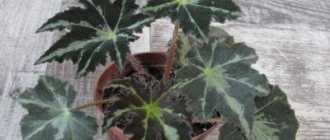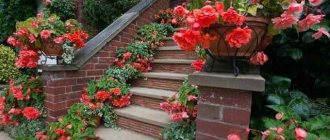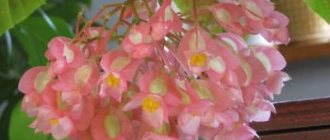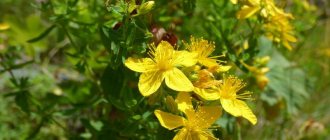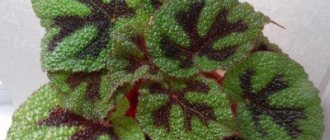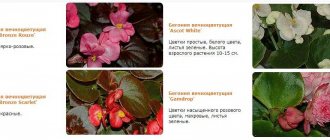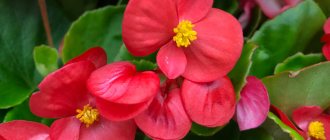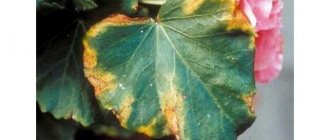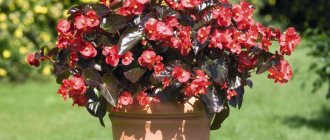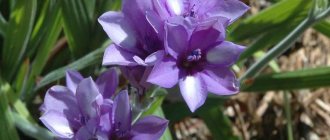Bolivian begonia: description and photo
This species is classified as ampelous, although initially the shoots of the flower rush upward, but after reaching a height of 30 cm they spread out and fall down in multi-tiered cascades.
The plant is a dicotyledon; the fruit is a capsule with seeds. Belongs to the tuberous family.
Under natural conditions, begonia is found in tropical forests and on mountain slopes. The flower's homeland is South America, the eastern part of the Andes. The flower is also found in Africa, but only in the Western part, where a humid climate prevails.
Bolivian begonia looks luxurious. It has bright, green leaves with a jagged edge, the flowers are elongated, somewhat reminiscent of bells. The height of an adult plant can range from 0.3 to 0.45 m.
The flowers are bright, orange-red.
More information about Bolivian begonia in the video:
Botanical description and history
Begoniaceae belong to the flowering division, the class of dicotyledonous plants . Herbaceous plant, subshrub, shrub, perennial, annual - all this is about different types of begonia. Begonias reproduce both by leaves and tubers, and by cuttings and seeds that ripen in fruit boxes. Read about how to propagate tuberous begonia from cuttings in our material.
The homeland of wild begonias is tropical rainforests in the mountains of Africa, Southeast Asia and Central and South America. Travelers brought exotic plants to Europe in the eighteenth century. Begonias quickly gained the love of collectors.
The list of begonias growing on European window sills was replenished with new species and varieties. The plants turned out to be not only gorgeous in appearance, but also unpretentious. Bolivian tuberous begonia grows wild in the highlands of the eastern Andes. This is a low, tuberous annual. It has an elegant appearance: elongated shoots with oblong leaves. During flowering, it pleases the eye with whole waterfalls of small, bright, graceful flowers, collected in small inflorescences.
Varieties
When it comes to Bolivian begonia, we most likely mean its most popular varieties:
- Santa Cruz Sunset, the plants are spreading, ampelous, the length of the shoots reaches 40 cm. Its flowers are very reminiscent of fuchsia, but have an orange-red color.
- Copacabana, an unpretentious variety, creeping branches, many flowers similar to bells, color - bright red.
- Bossa Nova, with shoots up to 50 cm long, flowers can be white, pink, red or orange, similar to fuchsia flowers. The flowering period lasts 5-6 months and ends with the onset of frost.
Variety of varieties
Currently, the sale of flowering plants and seedlings of Bolivian begonia is comparable to the sales of such popular crops as tuberous begonia, pelargonium and all kinds of balsams. Most of its hybrids are bred in vitro and propagated by cuttings. However, some varieties of Bolivian begonia can be grown from seeds. They differ from each other in many decorative characteristics, including the size, color and shape of leaves and flowers, as well as their placement on the stems. The number of varieties of this plant grown from seeds is large enough for every gardener to find a suitable variety.
Bolivian begonia: where to buy, how to grow from seeds
In the middle zone, the plant is cultivated as an annual. Sow seeds. Depending on what variety is grown, seeds are sown to obtain seedlings from January to the end of March.
The soil for growing seedlings is light and has high fertility.
To make your own soil mixture, use the following recipe:
- 1 part humus
- 1 part peat
- 1 part sand
- 2 parts leaf soil.
The seeds are not placed densely, directly on top of the leveled substrate. Do not sprinkle soil on top. Crops are often sprayed with a sprayer until the first shoots are noticed.
Next, the container with the seedlings is covered with film and placed on a warm, well-lit windowsill.
The greenhouse is ventilated daily by opening it for 10-15 minutes. If the soil surface dries out, spray with warm water.
The emergence of seedlings will have to wait 2 weeks, and this is if the soil temperature is not lower than + 20 C.
For normal development, daylight hours are required to be extended, i.e. It is possible that illumination with a special lamp will be required.
The first picking is made after the appearance of the third leaf; during this period it is advisable to lower the temperature to +16 +17 C.
After 2 months, a second pick is made, the temperature should be lowered another couple of degrees.
During the same period, the first fertilizing is carried out. Fertilizers use nitrogen-potassium fertilizers.
Growing from seeds
Bolivian begonia is an annual flower. It is grown from seeds and seedlings are planted in open ground.
Seeds are sown in late winter - early spring.- Seeds (in granules) are laid out on the surface of moist, loose soil. You can place an even layer of calcined sand on the soil surface and lay granules on it.
- Moisten the seeds regularly by spraying, avoiding drying out.
- In order for the sprouts to hatch, you need to create a “mini-greenhouse” for them - cover them with a translucent material (glass, cellophane film, plastic) and place them in a well-lit, warm place. Open the greenhouse briefly every day and spray the seeds as needed.
- After 13-15 days you can expect the emergence of seedlings. For this, the soil must have a temperature of at least +20 Celsius.
- It is recommended to transplant the seedlings after the leaves appear. The seedlings are placed in cassettes with soil 3 cm deep, and the temperature should be reduced by 2-4 degrees.
- The grown seedlings will need to be replanted again: in a container about nine centimeters deep (the temperature should be reduced to 15 degrees Celsius).
- It is best to lengthen daylight hours for seedlings using special lamps.
- Seedlings are “relocated” to open ground after stable warmth has arrived and there is no risk of sudden frost. You can also place potted plants on the balcony or patio.
Bolivian Begonia is a charming and easy-to-care plant . By following simple recommendations, you can grow it at home or on your property and enjoy its beauty all summer long.
If you find an error, please select a piece of text and press Ctrl+Enter.
Bolivian begonia, propagation by cuttings
Since growing seedlings from seeds is not so easy, the cutting method is often used. The first seedlings are purchased from breeders or specialized garden nurseries.
Cuttings are grown in containers; it is recommended that their diameter be about 15 cm; 2 cuttings can be planted in one pot.
To avoid the development of diseases, cuttings are treated with fungicides before planting.
The development of plants should be monitored, because You will need to do some pinching, usually leaving 3 pairs of leaves. If time is lost, you will need to complete the procedure 2 weeks after planting.
The optimal temperature for keeping them during this period of life is from + 18 to + 20 C, then it can be lowered to +15 C. The leaves should not be exposed to direct rays of the sun; it is best to organize partial shade.
The need for watering will appear after the soil surface dries out. The frequency of applying potash fertilizers is once every 10 days. It will take one and a half to two months to grow seedlings. Then they are planted in a permanent place.
Let's find out in more detail how to grow begonia from cuttings, watch the video:
Bolivian begonia - a beautiful flowering plant for indoors and gardens
BEGONIA BOLIVIANA
Bolivian begonia was known back in the 19th century, but for a long time it was used only as breeding material for breeding varieties and hybrids of tuberous begonia. And only recently have they begun to create new hybrids of this type of plant, which not only have a spectacular and beautiful appearance, but also tolerate heat and drought well. Bolivian Begonia attracts attention with its graceful elongated leaves, thin drooping shoots and simple small flowers of a brilliant red hue that resemble elongated bells.
The birthplace of this culture is the eastern slopes of the Andes (Bolivia and Argentina). In 1864, it was discovered in Bolivia and brought to England by the botanist Richard Pierce, and three years later presented it for public viewing at an exhibition, where the plant left no one indifferent to its beauty.
In the wild, it often grows separately, settling in mountain crevices near streams. Moist air and fogs of mountain forests are favorable for it, from which we can draw a conclusion about the conditions of its maintenance and cultivation.
Bolivian begonia - Begonia boliviensis, belongs to the tuberous plants. It grows no higher than 30-45 cm, and its stems creep or hang down to 80 cm. They are covered with lanceolate, jagged green leaves. Bright orange-red flowers on short peduncles are grouped in groups of 2-3 and look down. The species grows well in a small amount of soil. It was this property that attracted the attention of breeders, who began to create special varieties for hanging containers, portable containers and pots.
► BEGONIA ETERNALLY FLOWERING
Bolivian begonia is grown as an annual and is distinguished by lush and long-lasting flowering, a wide variety of colors, enhanced growth, good branching of shoots and a spectacular appearance. All these qualities allowed the crop to quickly take one of the first places in industrial world floriculture. To date, sales of seedlings and flowering potted plants of Bolivian begonia are equal to sales of pelargonium
,
tuberous begonia
and various types of
impatiens
.
Most of its hybrids are obtained using in vitro (tissue culture). They are propagated by cuttings. But there are some cultivars that can be grown from seeds. BEGONIA BOLIVIA FROM SEEDS – SERIES AND VARIETIES
Bolivian begonia hybrids (Begonia boliviensis x hybrid) grown from seeds include
Santa Cruz
.
Plants of this series at the very beginning produce small, neat bushes with vertical shoots. As the plant grows and develops, the shoots quickly lengthen and bend. Over time, the wide bush reaches a height of almost 30 cm, and the length of the shoots can reach up to half a meter. Green elongated narrow leaves form a spectacular background for a large number of elongated bell flowers of a reddish-orange hue. The bushes bloom 14-18 weeks after sowing the seeds. They can grow in well-lit areas and in small openwork shade. The Bolivian begonia “Bonaparte”
consists of 4 hybrids with pink, orange, red and white with pink shades of flowers. The bushes are formed by shoots that branch beautifully without pinching. It takes a long day for them to bloom.
Hybrid plants that reproduce by seeds have a wide variety of decorative characteristics.
They differ in the size of the plants, the shape and color of the flowers and leaves, as well as their location on the bush. "Belavista"
stands out for its spreading form, dark green leaves, orange and red flowers.
The Belladonna
series is valued for its compact bushes with large, non-double flowers, colored pink, white and red.
"California Sinligt"
attracts attention with semi-ampeloid bushes about 30 cm high and wide, which are highly resistant to bad weather conditions. The orange flowers with a diameter of 2.5 cm, which are located above the leaves of a dense green hue, look especially beautiful.
►GAURA
►DICHONDRA
Ampelous plants
"Bonfire"
with graceful shoots and small orange or shiny red flowers reach a height of 35 and a width of 50 cm.
"Graskling Fir"
stands out for its small, neat plants with well-branched and straight shoots.
Their height varies from 30 to 40 cm. The spectacular appearance of the bushes consists of beautiful green foliage and small flowers of 8 colors: white, creamy pink, yellow, pink and various shades of red. Mistral
series consists of semi-ampelous bushes 35-40 cm wide and 25-30 cm high with flowers painted in red, orange and dark red shades.
"Million Kisses"
attracts with spectacular hanging bushes 25 to 30 cm high with long branched shoots (75-90 cm). Small flowers of pink, yellow, orange-pink, white-pink and deep red shades bloom earlier than other hybrids.
►GROWING PETUNIA IN A CONTAINER
Semi-ampelous plants of the Sparkler
(Sparkle) reach a height of 25-30 cm. A large number of flowers, painted in white-red, yellow, white-pink, pink and red shades, are located over the entire surface of the bush.
Plants of the “Summerwings”
were obtained using tuberous begonia, and therefore ampelous and semi-ampelous bushes have larger leaves and flowers than Bolivian begonia.
The series consists of 10 varieties with a variety of colors (white, cream, pink, apricot, various shades of orange and red). Interestingly, the flowers can be either simple or semi-double. The dark green leaves of these varieties have brownish-bronze veins. The ampelous bushes of the "Bon Bon"
, about 25 cm high and 50 to 55 cm wide, grow well and bloom in the shade with low humidity.
Flowers with large outer petals and a large number of small petals inside can be painted in a bright pink or creamy pink shade with yellow src=»https://www.pro-rasteniya.ru/images/cvetnik/odnoletnie/Begoniya/Begoniya_boliviyskaya_Copacabana. jpg" class="aligncenter" width="360″ height="342″[/img]The "Angel Fels"
has semi-ampelous bushes from 30 to 50 cm in height with large semi-double and simple flowers.
They are painted in deep orange, soft pink and white-yellow shades. Green wide leaves are located along the entire length of the shoots. Another interesting hybrid, “Growing Embers,”
is distinguished by large leaves of a dense green color and small orange flowers located above the leaves.
These bushes are grown in containers with a diameter of at least 12 cm, and planted in portable containers and concrete flower boxes, with the exception of hanging flowerpots. Complex interspecific hybrids are also grown from seeds. They are distinguished by their strong growth and flowers, which are collected in raceme-type inflorescences. The most famous of them are the “Dragon Wing” F1
and
“Big” F1
with large flowers with a diameter of about 8 cm and well-branched shoots.
In begonias “Big” F1, the flowers are located above the leaves and look up, while in “Dragon Wing” F1 they hang in the form of clusters. Young bushes 15-20 cm high during the summer grow up to 80 cm. Plants of the “Big” F1 series have green and brown-bronze leaves, as well as pink and red flowers. Bushes "Dragon Wing" F1 with graceful elongated leaves and large red-pink and red flowers, collected in drooping clusters, look like bush begonias. Plants in this series have good resistance to heat. Among the latest varieties of Bolivian begonia “Bosa Nova”
F1 (Bossa Nova).
The hybrid can have flowers of red, pink and white colors, its hanging shoots reach 40 cm. The new series of the Czech selection “Copacabana”
F1 (Copacabana) is represented by varieties with red, salmon, orange, yellow and white fuchsia flowers with a diameter of up to 6-7 cm Plants up to 35 cm high thrive in bright sun, partial shade, and shade, and can withstand rain and drought.
In the shade the leaves are dark green, in the sun they are lighter. “Copacabana” initially grows vertically, but then forms creeping and drooping shoots, so it is suitable not only for flower beds, occupying a space of up to half a meter or more, but also for growing in hanging baskets. GROWING BEGONIA BOLIVIA FROM SEEDS AT HOME
Bolivian begonia is grown as an annual crop.
Depending on the variety, sowing is carried out at certain times; usually the seeds are sown from January to March in fertile and light soil. They are placed on top of a layer of leveled and moistened substrate, but it is better to cover the soil with a small layer of calcined sand and then spread granules with seeds over it. The seeds are not sprinkled, but moistened with a sprayer. They should remain moist throughout the entire period until good seedlings appear. The crops are covered with transparent material (glass, polyethylene, plastic), creating a mini-greenhouse, and placed on a bright window with a warm windowsill (near the radiator) or other similar place. Airing is carried out daily for 10 minutes; if necessary, the crops are carefully moistened with warm, settled water from a sprayer. Seeds germinate in two weeks at soil temperatures above +20 degrees. The seedlings are replanted twice: when there are one to three leaves and after 60 days. The first time they dive into 3-centimeter cassettes, and reduce the temperature to +16-18 degrees so that the plants do not stretch. The second time, the seedlings are transplanted into 9-centimeter pots, providing a temperature of +15-16 degrees. This plant needs long daylight hours, so the crops are illuminated with phytolamps. Some of the subtleties of growing seedlings from seeds can be seen below using the example of industrial cultivation of Bolivian begonia. CARE OF PLANTED PLANTS
Plants are planted in a permanent place after the threat of spring frosts according to the 30X30 pattern, at which time the containers can be taken out into the open air.
The best location would be partial shade, but other options are also acceptable. Light and fertile soil with a pH of 5.5-6 is suitable for planting. It can be improved by adding compost, humus, peat, as well as complex fertilizers for flowering crops to the garden soil. Containers can be filled with special soil for begonias. For long and abundant flowering of Bolivian begonia (and it can last from June to September), fertilizing is carried out with a soluble complex of mineral fertilizers with a preponderance of potassium, but not nitrogen. When planting in open ground, this is done twice a month, in a container - once a week. Among the growing problems are those typical of all begonias. These are powdery mildew, gray rot, ring and bacterial spots. Among the pests, enemies can be greenhouse thrips, aphids and whiteflies, as well as false scale insects and nematodes. Compliance with agricultural practices will help you avoid them, and if they occur, use special preparations from stores. PLACE IN THE GARDEN AND AT HOME
Bolivian begonia can be kept in open and protected ground.
It is planted in flower beds
, flower beds,
rock gardens
, where flowering shoots cover the space with a radius equal to their length.
They also hang in thick cascades from vases, containers and hanging baskets in gardens and on outdoor patios, balconies and verandas. It is better to place the plant in places protected from the wind - having fragile stems, it may suffer in bad weather. As an indoor
hanging plant, Bolivian begonia is placed in apartments and winter gardens.
This plant will feel comfortable on windows oriented to any side of the world. BOLIVIA BEGONIA FROM SEEDS ON THE EXAMPLE OF INDUSTRIAL CULTIVATION
Growing Bolivian begonia from seeds is practically no different from ever-flowering begonia. The only difference is the time of cultivation and earlier sowing. To grow flowering plants of the Copacabana, Santa Cruz and Dragon Wing F1 series, it takes from 14 to 17-18 weeks, and for Big F1 hybrids - from 13 to 14 weeks. To correctly calculate the sowing time (from December to February), you need to take into account the growing time, the date of sale and the size of the container in which the seedlings will be grown. For example, when sown in January, “Copacabana” will bloom in May, subject to all the rules of agricultural technology.
Bolivian begonia seeds are sold only in the form of pills (the seeds are coated).
To get 1000 young plants, 1100 seeds are sown. In industrial floriculture, cassettes with 288 cells are mainly used for growing Bolivian begonia. But for the Dragon Wing variety series F1, they are suitable for 200 cells, since seedlings of this species grow somewhat faster. In addition, you need to take into account that the first stalk deviates to one side, and in smaller cassettes it does not have time to grow enough for this deviation to become more noticeable. This nuance of cultivation must be taken into account, since when transplanting, seedlings are placed so that the stem leans towards the edge of the container. Seed germination temperature and illumination.
Sowing cassettes are filled with loose and nutritious soil with neutral acidity (pH 5.8 - 6.0) and a low salt content. The optimal germination temperature is 22-24 degrees
Celsius.
At high air and soil humidity (95%), seeds germinate within 7-14 days. It all depends on the variety. During seed pecking, constant soil moisture is maintained. Also, when Bolivian begonia germinates, low light is required, so the seeds are not sprinkled with soil after sowing. After the seedlings appear, the temperature is maintained at 21 degrees for 15 days. And for plants of the Dragon Wing F1 variety, the temperature is left the same. The soil moisture is slightly reduced, but be sure to ensure that it does not dry out. As the seedlings grow, the illumination is increased to 20,000 lux, but they should not be in direct sunlight. When growing the Santa Cruz hybrid, the daylight hours are 14 hours. Low soil moisture should be maintained evenly at the same level. After the root system has developed, the temperature is reduced to 18 degrees. Growing after picking
After one to two months, the seedlings are transplanted into containers with a diameter of 10 to 12 cm. The Santa Cruz hybrid grows the fastest. Plants of the “Dragon Wing” F1 series are kept in cassettes for almost 8 weeks, and are transplanted so that the stem of the seedling bends towards the edge of the pot.
Young plants are grown in fairly strong light (30,000 to 70,000 lux) and a temperature of 17 to 19 degrees.
For plants of the Dragon Wing F1 series, the optimal growing temperature is 15-18 degrees at night and 18-21 during the day. All this time the soil is kept moderately moist. Excessive watering has a particularly bad effect on Santa Cruz bushes. Feed the plants with fertilizers containing nitrogen and potassium once a week. Moreover, there should be much more potassium in the composition than nitrogen. To get neat and compact bushes with beautiful dark green foliage, additional foliar feeding (on the leaves) is carried out with a solution of potassium fertilizers. To prevent plants from stretching, you need to arrange them in time so that they do not intertwine or touch each other’s leaves. GROWING BEGONIA BOLIVIA FROM CUTTINGS AND SEEDLINGS
Since sowing in the early stages of the “Dragon Wing” F1 and “Big” F1 series of plants is not always easy, it is better and more profitable to grow purchased seedlings. Rooted cuttings of begonias, which are propagated vegetatively, are planted 1-2 pieces in containers with a diameter of 10 to 15 cm. Before planting, they are sprayed with fungicides. The tops of the cuttings must be pinched, leaving 3-4 pairs of leaves. And if this was not done during rooting, then this will need to be done 15 days after planting. For plants obtained from seeds, this procedure need not be carried out.
► Ampelous impatiens
During the first few weeks, the temperature at night is maintained at 18-20 degrees, and then lowered by 2-3 degrees. The leaves of cuttings and seedlings must be shaded from direct sunlight.
For the Bon Bon series, the daylight hours should be at least 13 hours, since in insufficient light the plants grow poorly and bloom poorly. Watering of rooted cuttings and seedlings is carried out only after the soil has dried. Fertilizing is carried out with mineral fertilizers with a high potassium content and a small amount of nitrogen every 5-7 days. The entire growing period in containers with a diameter of 10-12 cm is 6-8 weeks or more. Growing Santa Cruz seedlings takes longer. This is approximately 7 to 10 weeks. Ready seedlings of the Belavista and Belladonna series with a height of 25 to 30 cm are grown in 10 to 12 weeks. Young begonias of the “Dragon Wing” F1 and “Big” F1 variety series reach a height of almost 30 cm at the time of sale. If the bushes are grown in large pots (14 -16 cm), then they are additionally grown for another 2 weeks.
“Website about plants” www.pro-rasteniya.ru
RETURN TO SECTION
| < Previous | Next > |
Features of care and watering
Everything that will be said about care is not so necessary; seedlings planted in the ground will survive in any case. But if you want to get a truly amazingly beautiful, properly formed flowering bush, then it’s a good idea to follow the care recommendations.
It is recommended to water the begonia moderately, but do not allow the soil to dry out or become waterlogged. Since the plant is moisture-loving, you can periodically spray water around it, but it is not advisable for it to get on the leaves.
Feeding an adult flower is systematic, with fertilizers high in phosphorus and potassium. These minerals are necessary for bud formation and long flowering. Fertilizers are applied once every ten days.
Rules of care
- Begonia is unpretentious in care and does not take much time . Pruning and fertilizing are not necessary.
The pot must be placed in damp peat . This is done in order to create optimal humidity. Excess moisture causes the plant to rot. Humidity must be maintained at least 60 percent.- In summer, the plant must be sprayed . It is best to water in the morning. Water should not get on the leaves. In autumn, do not water until the leaves turn yellow.
- The plant should be fed once a month . Mineral fertilizers are suitable. When the begonia reaches 10 centimeters in height, it is necessary to start feeding.
- In summer, begonia can be taken outside . The plant will be in a stressed state for several weeks, the leaves may partially fall off, but then everything will return to normal. When the conditions for its favorable existence change greatly, a period of stagnation and rest will begin.
ATTENTION! In winter, the plant should be kept away from the window, otherwise the begonia will suffer greatly.
Begonia lovers will be interested in information about growing and caring for the following varieties and types of begonias:
- Naked begonia;
- Smaragdovaya;
- Mason's Begonia;
- Ever-blooming begonia;
- Begonia Elatior;
- Begonia fista;
- Begonia Rex;
- Royal begonia;
- Griffith's begonia.
Trimming
To get beautifully flowing branches, Bolivian begonia needs to be pruned correctly. This procedure helps rejuvenate the plant and improves the quality of flowering.
Since the green mass will grow very quickly, pruning should be done in a timely manner. In case of untimely pruning, all the flower’s energy will be spent on growing greenery, and flowering may stop.
Bush-forming pruning is performed when the stem length is up to 8 cm; when the length reaches 13 cm, the tops are cut off to stimulate the growth of side shoots.
Next, the procedure is carried out as the shoots grow, the tops are removed, redirecting growth to the side shoots, which, in fact, allows you to create a beautiful cascade.
Pruning is done not with scissors, but with a sharp knife, this reduces the traumatic nature of the procedure.
Description of appearance and features
Bolivian Begonia has a very attractive appearance. This plant has elongated leaves and beautiful flowers that look like elongated bells. Hanging shoots. In nature, the plant lives separately.
REFERENCE! Begonia is a tuberous plant. It reaches a height of 30 to 45 centimeters. The stems are covered with green jagged leaves. The flowers are usually two to three on one plant and are red-orange in color.
Diseases of Bolivian begonia
The most dangerous pests of begonias are spider mites, aphids, and nematodes. Fungal infections, namely gray rot, are often observed. To combat these scourges, fungicide treatment is used.
Some plant ailments can be caused by errors in care:
- in poor lighting, leaves may become pale
- with insufficient humidity, wilting and yellowing of leaves and buds may occur
- Excessive watering can cause powdery mildew, which will appear as a whitish coating on the leaves and lead to further curling and drying out.
- With irregular watering, the tips of the leaves can curl and dry out.
Having noticed such symptoms, you need to think about adjusting your care.
Caring for ampelous begonia at home
Begonia is considered to be an unpretentious plant. But even the most spartan representatives of the flora need certain conditions. Provide them with this - they will thank you with their appearance, decorating the house.
To understand the care requirements, you need to get acquainted with the homeland of begonias: tropical humid but not swampy forest, diffused but bright light without direct rays, trees that protect from wind and drafts, pleasant temperatures without changes to heat or frost and nutritious soil from leaf litter.
Lighting
To ensure optimal placement of the flower not in the scorching direct sun, but to give it enough light, it is better to choose eastern and western places in the apartment or in the yard. Then the sun will fall on the begonia in the morning and afternoon: in the interval from 11 to 16 hours it is better to provide it with shading; you can keep the pot behind a curtain. In the shade, begonia will also survive quite well, but the flowering will not be as massive.
Temperature and humidity
Begonia does not require high temperatures; it grows quite comfortably at 18-20 degrees, and even lower. An increase is undesirable, as the edges of the leaves begin to dry out. But if, on the contrary, there is a drop in temperature, and also an overflow in the soil, expect fungi. The winter temperature of specifically ampelous representatives can be below 10 degrees.
Humidity is desirable within 60%.
To maintain it, you need to spray the flower with water without chlorine, otherwise there will be white calcium spots on its surface. The sprayer needs to be finely dispersed so that the droplets are not large and do not act like lenses in the sun and cause burns.
Begonia loves a warm shower, like a tropical shower. After this, the plant must be dried in air, not exposed to the sun. It would be ideal to keep the pot hanging near a decorative pond. In the apartment you can place a tray with wet pebbles or moss for evaporation.
Watering and fertilizing
The plant asks for water regularly and in moderation: it does not approve of drying out or overwatering. He prefers the humidity of the air rather than the soil. You also need to protect the tuber from direct contact with water, so you need to water it carefully, masterfully, directing the stream to the edge of the pot or even filling the tray. It is advisable to use rain, melt, filtered or settled water so that the volume of impurities in it is minimal to avoid soil salinization over time.
It is also better to apply fertilizer without fanaticism, keeping in mind the excess salts.
To be safe from this, you can slightly reduce the dose indicated in the instructions. The frequency of application is 1-2 weeks. Closer to autumn, take more and more pauses, and stop when the stems wilt.
At the beginning of the growing season, begonias need nitrogen for intensive growth. Then the flowering period begins, nitrogen is no longer required in large quantities, it is replaced with potassium and phosphorus. For ease of use, you can buy liquid fertilizer at a garden store marked “for ornamental flowering plants.” The plant will not refuse minerals and even organic matter. The latter is a good idea to add to the soil when planting.
Preparing for winter
The ampelous species belongs to the tuberous begonias, so in winter they have a pronounced dormant period. After flowering ends, all above-ground parts of the plant dry out and die. After this, the tuber must be removed from the pot, cleaned of soil and dry residues and stored in a cardboard box with moss or peat at a temperature of 5-12 degrees until spring. This could be a basement, pantry, veranda, balcony, fruit container of the refrigerator.
It is worth checking the tubers periodically for mold or excessive drying.
There are times when wintering fails (perhaps the humidity or temperature has changed), and begonia buds wake up earlier than spring. If this is ignored, the plant will die. You should plant it according to all the rules, water it and arrange a “spring” by turning on the phytolamp for additional illumination.
Typically, tuberous plants require a 3-month dormant period. Young plants that just appeared in the first season may not go into hibernation. They should be left on the window, watered moderately and the temperature should be at least 15 degrees. In spring, shorten winter shoots. You can use the cuttings as cuttings.
It will also be interesting: Balsam (Vanka wet flower, light, touch-me-not) - types and names?
How to preserve begonia in winter, proper organization of wintering
Flower tubers require special winter storage conditions. Small plant tubers are usually placed in plastic bags, covered with peat and placed in a cold place, for example, on the bottom shelf of the refrigerator. The tubers are periodically inspected, and seedlings that appear untimely are removed.
You can also consider keeping plants in boxes in winter, in a fairly cool and well-lit room. This option requires periodic watering. With the onset of warmth, the bushes are planted in separate containers with fertile substrate.
Planting in open ground is carried out after the onset of stable heat.
If the tubers are small and weak, then they are stored in a cool basement. They require periodic moistening, otherwise they may dry out.
It should be understood that although the growth of shoots in plants of the first year of life stops in winter, talking about the dormant period is conditional, because shoots do not disappear for the winter.
Varieties with photos
The most popular varieties of hybrid Bolivian begonia are “Copacabana” and “Santa Cruz” . Both reproduce by seeds and grow to a height of 30-35 centimeters. Then active growth of shoots occurs. Due to this, begonia either forms an ampelous shape or carpets a flower bed (you can find out what kind of plant ampelous begonia is and how to grow it here, and here we told you how to plant an ornamental plant and care for it at home and in the open ground). Below are descriptions of these varieties with photos.
Copacabana
It blooms with a lush heap of orange flowers. It is positioned as a plant that is quite resistant to both dry and rainy weather, as well as direct sunlight.
Santa Cruz
During flowering, it delights with cascades of flowers in orange-red tones. It is also unpretentious to conditions, like Copacabana. It can grow and bloom well both in partial shade and in fairly bright sun.
Winter care for begonia, which is grown as an indoor flower
If the flower is grown in flowerpots, then its flowering will last until late autumn. The onset of autumn cold is associated with the beginning of a state of dormancy.
Plants are not replanted during this period. Watering is reduced. Moisten the soil substrate only if it dries out.
Since the air humidity in the apartment drops sharply with the beginning of the heating season, you should spray water from a spray bottle near the plants (not on the leaves!).
You can also place the pots in containers filled with gravel and periodically add a little water to them.
Reproduction and planting of begonias
Ampelous begonia propagates easily and with a high percentage of success. The following methods are used for this:
- Seeds. Labor-intensive, but allows you to obtain a large number of seedlings if you need to decorate a large area. It is worth recalling here that if you need begonia of a certain type and variety, it is useful to find out whether it is a hybrid, since in this case the seeds are needed only from breeders. Their own collection is not suitable - one of the ancestors will grow from them, and it will not necessarily be ampelous or with the necessary flowers in shape and color.
If all the conditions for choosing seeds are met, then you can proceed. To ensure suitable conditions (increased daylight hours, low temperature), February-March is chosen for sowing. It is better to buy granulated seeds themselves, since thanks to the nutrient shell they become larger, and it is easier to sow them individually, so as not to have to pick them later.
It is convenient to sow in small cassettes with loose peat substrate or in peat tablets, having previously soaked them.
It is necessary to place the seeds in cells and moisten them with a sprayer, cover the crops with film and carry out further watering through a tray. The air temperature at the time of sowing should be 22-23 °C. The first shoots should be expected after 2 weeks.
After this, lower the temperature to 20 degrees. The appearance of the third leaf of the plant is a signal to transplant it into pots along with the substrate of the tablet or cassette in which it sprouted, so as not to injure it. Continue to care for it as you would for an adult flower.
A full-fledged tuber of a sown begonia will grow in almost a year.
In the case where the seeds are without a shell, the actions are almost the same, only sowing is done in boxes, and the seedlings are picked using miniature tools. The work is almost jewelry-like, complex.
- Cuttings. Fragments of stem and leaf can serve as cuttings. The procedure can be carried out in spring and autumn. Autumn shoots need to be separated before the start of winter withering, and spring shoots - after awakening and the stems have grown 10 cm, waiting for three leaves.
You need to cut off the internodes with two leaves, the third one must be left on the adult plant. The exception is when the tuber is young, and we do not allow it to produce too many shoots; we remove the excess ones for the benefit of propagation.
Dip the cuttings into a growth stimulator, then powder with crushed activated carbon and dry for several hours.
Then stick them into cups with soil mixture and cover them with a bag, creating something like a greenhouse.
In about a month, rooting will occur, this will be noticeable by the new leaves. You need to transplant it into a larger container as the begonia grows. If the cutting is a leaf, then rooting is carried out in water, immersing the petiole 1 cm in water. Over time, white roots form there, and then the seedling is carefully transplanted into the ground.
- Tuber division. For this you need a large old tuber with more than 7 buds. It needs to be cut with a sharp, clean knife into several parts across so that each has 2-3 buds. Dry the cut, sprinkle it with activated carbon, and plant it in the manner described below, like a regular whole tuber. This method is good for its double result: in addition to obtaining individual plants, the mother plant is also rejuvenated, because the old 5-6-year-old flowering is already weaker.
The landing procedure provides for the following conditions and actions:
- It is worth choosing large tubers, at least 3 cm in diameter. The exception is small-flowered specimens. In any case, planting material must be of high quality and healthy. Inspect it for stains, mold, damage, or dry fragments. The tuber should have dormant buds, similar to tubercles, in an amount from 3 to 7 pieces. Further:
- First you need to “wake up” the tuber. To do this, lay it with its convex part on a damp cloth, moss or sand and periodically irrigate it with a sprayer. This condition should be maintained until white roots appear. This will be a sign that the plant is healthy and ready to plant.
- The shape of the begonia pot also has its own characteristics - it should be shallow and wide, this is dictated by the shape of the rhizome. A drainage hole must be made.
And since our plant is a hanging plant, we must not forget about the method of hanging the pot.
- Drainage is also needed: expanded clay, pebbles, clay shards. Soil is poured onto their layer, then the tuber is carefully laid out with the roots down and sprinkled with earth only on the sides. The upper part, where the growth points are located, remains open until the shoots grow; they should have 3 leaves before being completely, but not deeply, covered with soil - up to 1 cm maximum. After planting, you need to water it delicately, without getting on the tuber.
- Next you need to look at the quality of the shoots and leave the 3 strongest ones, plucking out the rest so that the young begonia has enough strength.
Subsequently, when in the following seasons the plant becomes older and stronger, it will be possible to leave even up to 7 stems.
- The soil required is slightly acidic or neutral. There is a special one for begonias on sale. But in fact, it is not difficult to prepare it yourself. To do this, take sand, leaf and turf soil and mix in proportions 1:4:1. To avoid fungal diseases, it can be calcined in the oven.
- Freshly planted begonia should be kept in a warm place.
It will also be interesting: Terry lilies - varieties with names and care at home?
How it is used in landscape design
The plant is often used to create a landscape garden. Planted in flower beds and flower beds as a creeping plant.
Often used for planting in hanging pots, flowerpots or containers that decorate verandas or terraces. A good option is to plant them in boxes to decorate the balcony.
Diseases and pests of ampelous Bolivian begonia
The most common problem with tuberous begonias is fungi: gray rot, leaf rot, powdery mildew. All of them are accompanied by spots and damage to leaves, stems and tubers. The way out of the situation is to remove the diseased parts and treat the plant, soil and pot with fungicides. As a form of prevention, firstly, you need to comply with watering and temperature conditions, and secondly, you can use the drug Mikosan, which populates the soil with the necessary fungi that destroy pathogenic ones.
Among the pests that begonia likes are greenhouse aphids, soft scale insects, thrips, nematodes, and greenhouse whitefly.
They can appear when the plant weakens, and can also come from other infected neighbors. Therefore, insecticide treatment can be carried out for prevention by everyone, especially if the plant is located outdoors. There are many drugs for this, all of them are effective, they differ only in the degree of toxicity, so here you need to make a choice.
But you should understand that environmentally friendly drugs are definitely safer in the room, but on the street, at first glance, you can use an aggressive product.
But there is such a point: modern eco-friendly products are designed in such a way that they affect specific pests, while remaining safe for other insects, such as bees, ladybugs and others. It is important to think not only about personal well-being, but to act meaningfully in relation to nature as a whole.
Peculiarities
This plant does not tolerate excessive humidity and low temperatures very well. For active growth and development of Bolivian begonia, about 14 hours of light and a comfortable temperature exceeding +13 degrees are required. In order for a flower to please the gardener, it is necessary to provide it with fertilizing containing nitrogen.
Planting outside too early can harm the plant. You should wait until the air temperature becomes comfortable, otherwise the begonia will get sick. Later planting will promote easy growth and faster flowering.
Reproduction
The easiest way to propagate begonia is using stem cuttings. To do this, a small section of the stem is placed in moist soil. You can cover the container with a plastic bag, this will speed up adaptation. The main thing is to maintain a temperature regime of around 20 degrees and slightly higher. If the necessary conditions are met, the sprout will appear in 1-2 months.
You can also use leaf sections, which are divided into pieces or placed entirely in the soil. Sprouts emerge from cut veins.
Growing begonia from seeds is quite labor-intensive. Since the seeds are very small, the sprouts appear small and fragile, and they also take a long time to develop. However, if such a decision was made, you need to do the following.
- The plant needs to be sown at the very beginning of the new season, usually this is done in January-February. Artificial lighting will be required, since daylight hours in winter are very short. Begonias need 14 hours of light daily. Only in this case will the sprouts develop evenly. It is recommended to use a fluorescent lamp.
- When the first shoots appear, which happens after 1-2 weeks, you need to remove the plastic bag from the container to provide oxygen to the plants. Picking occurs after 2-3 leaves appear on each sprout. We must not forget about timely, very careful watering. Soluble fertilizers will also have a good effect on seedlings.
- When it gets warmer outside, the seedlings will need acclimatization. To do this, they are exposed to fresh air for several hours every day. If transplanting outside is not planned, the plant can be left indoors.
What to do with begonia in winter?
If the plant spent the summer outdoors, even before frost begins, it must be moved indoors. Low temperatures are quite capable of killing begonias. To simplify acclimatization, the procedure should be done in early autumn, then the flower will more easily tolerate changes in environment and humidity level.
The plant must be carefully examined and, if pests are found on it, appropriate treatment must be carried out immediately. In advanced cases, it is recommended to get rid of diseased plants. It is better to place a flower pot in a room facing east. Begonia loves diffused lighting; if it was in the shade outside, too much sunlight can be harmful.
As for watering, after it you need to empty the pan of excess liquid, since the flower does not like excess moisture. Light fertilizers won't hurt. The average optimal temperature is about 20 degrees; at night the thermometer should drop no lower than 12 degrees. This is especially true if the pot is placed on a window that tends to freeze.
If a begonia begins to lose leaves after changing its habitat, this may be a consequence of shock after moving to a new habitat. There is nothing critical about this, new leaves will soon grow, you can help the flower a little by simply cutting off the long-legged stems.
Tuberous (Tuberhybrida)
These are unpretentious perennial plants. They look stunning, are versatile and extremely popular. Tuberous begonias owe their name to the fact that they form underground roots in the form of a tuber, with the help of which they reproduce.
Begonia Grandiflora mix
The most popular variety is the large-flowered begonia (Begonia x tuberhybrida grandiflora) with its brightly colored large double flowers, a bit like roses. Inflorescences in open ground can open up to 20-30 cm in diameter, although when grown indoors they are much more modest. It is difficult to describe in words what the flowers of tuberous begonias look like. Flowers come in all shades of white, yellow, orange, pink, red and burgundy. Two-tone colors are not uncommon, such as pink with a dark red border.
Begonia Dark Red
The bush is semi-spreading, no higher than 16 cm. Bright green leaves are edged with a thin purple border. The flowers are large, double, deep dark red. Their diameter is about 10 cm. They resemble peonies in shape.
Begonia Camelia Flora
This is a small bush, up to 25 cm in height. The leaves are green. It is characterized by large double flowers (up to 12 cm) of pink color and white edging along the edge of the petals. The shape of the bud resembles a camellia. The petals have a tiled arrangement.
Begonia "Rose Bud" (Begonia Bouton de Rose)
Large, up to 18 cm in diameter, double flowers of this variety look like delicate roses due to the fact that in the center of each bud there is a group of petals, curled like rose buds. White-pink petals are edged with a bright pink edging.
Begonia "Crispa Marginata White-Red"
A very elegant bush with simple wide oval frilled flowers, measuring 9 by 12 cm. The petals of this begonia are round and painted white. They overlap each other like tiles. Along the edges of the leaves there is a bright pink-red border. The outer petals are wide, the side petals are slightly narrower, and the edges of the petals are wavy, strongly corrugated, like ruffles. A very impressive bush.
Begonia "Diana Wynyard"
This is a small bush, about 20 cm in height. The leaves are pale green. Large (diameter about 20 cm) densely double fringed flowers consist of wavy folded white petals.
Begonia "Marmorata"
The height of the compact bush is about 20-30 cm. The leaves are heart-shaped, openwork, bluish-green. Terry large (about 12 cm) white flowers are decorated with pinkish-crimson strokes and an elegant dark cherry-colored border along the wavy edges of the petals. Flowering is abundant and long lasting.
Begonia Golden Wave
This variety has double flowers that are yellow with a bright orange border around the edges of the petals.
Some groups of tuberous begonias have common similarities in the structure of the bush and the shape of the leaves and inflorescences. They differ in the color of the buds.
Picotee
This group of begonias is considered a real miracle of nature. It differs from other representatives of this species in the special, two-color color of its inflorescences. During flowering, which begins in late spring and ends in mid-autumn, the bush is covered with many large flowers. The petals have a graceful fringe and follow in tiers, like scales on cones. The leaves are dark green. Check out some varieties in the photo gallery:
Fimbriata
This is not a variety, but a whole group of begonias that have double, heavily packed inflorescences with many fringed petals. The flowers are so lush and full, and the petals have such cut edges that the opened bud looks more like a large carnation than a begonia. The height of the bush does not exceed 25 cm. The following five varieties differ only in the color of the petals:
Terry (Double)
In the next series we selected tuberous begonias with compact bushes 35-50 cm in height. Their stems are slightly pubescent. The leaves are rich green in color and medium in size. The flowers are double, quite large, with a color characteristic of the variety:
Reproduction of ampelous begonias
Reproduction is typical for hanging begonias:
- tubers;
- seeds;
- cuttings
At the end of the plant’s active period, the gardener is faced with an important question: bring the plant indoors to continue the flowering period or dig it up to obtain tubers?
Propagation by tubers
Features of the transition of begonia to a state of rest and storage of tubers:
- After flowering is completed, ground shoots begin to die off (30-45 days).
- After the shoots have completely died, the tubers should remain in the ground for another 14-21 days to accumulate nutrients.
- After drying the tubers in a sunless and dry place, the plant is placed in a box with sand or peat.
- The optimal storage temperature for tubers is from +12 to +14 degrees.
- 2-3 months before planting, the tubers must be removed from the substrate and transplanted into pots with soil.
To increase the number of tubers, gardeners resort to a little trick. If there are a large number of old tubers in the planting, the workpieces can be cut in half, preserving the buds on each part. The cut site after surgery should be treated with charcoal to reduce the risk of infection.
If you purchase hanging begonia tubers in a store, you must carefully consider the appearance of the plant. There should be no visible signs of mold or physical damage on the surface. The recommended tuber size is more than 3 cm.
Propagation by seeds
Ampelous begonia is also grown using seeds, but this method is much less common.
Obtaining seeds and carrying out propagation:
- In order to obtain a seed, it is important to pollinate the begonia. The brush is used to transfer pollen from the male to the female plant.
- After successful pollination, the gardener receives numerous seeds, which should be planted in late December or early January (for flowers in the summer months).
- The seed is placed in leaf soil and tightly covered with glass to prevent the substrate from drying out.
- The required growing temperature is from +22 to +25 degrees.
- The ground is moistened and periodically ventilated by lifting the glass. This way you can avoid the development of mold and, as a result, the death of the plant.
- Germination is observed 14-16 days after planting.
- Then you should dive and plant young begonias at a distance from each other. When the leaves close, 3 stages of picking are carried out and planting is carried out at a distance of 2 cm, 4 cm and 6 cm from each other.
- After the next closure of the leaves, the begonia is transplanted into a pot with a diameter of up to 13 cm, watered and placed in a place with diffused light.
Growing a plant from seeds produces the healthiest crop, but it is a labor-intensive and time-consuming process.
When will begonia bloom? When growing a plant, it is worth remembering the individual characteristics of the variety; in some cases, begonias bloom only when they reach a certain age. On average, when planting seeds, buds appear 4.5-5 months after planting.
Cuttings
Propagation by cuttings is the simplest method that even a novice gardener can handle. To begin with, you should cut off part of the shoot (6-10 cm) with leaves, treat the cut area with charcoal and plant the cutting in the prepared sand. The plant is covered with a glass jar to reduce humidity levels.
Rooting of the cuttings is observed 2-3 weeks after planting, then the begonia should be transplanted into nutritious soil.
Ampelous begonia is a plant species characterized by a large number of different varieties, bright colors and bud shapes. Like other begonias, this variety is easy to care for and does not require significant experience in dealing with plant crops.
Watering and fertilizing
Begonia from seeds is a growing process, the success of which depends on the organization of proper subsequent care
Particular attention must be paid to watering and fertilizing. The plant likes moist soil, but avoid overwatering.
Stagnant water is considered the first cause of fungal microflora, which affects the thin roots of still immature seedlings.
It is recommended to keep the container at a slight angle so that condensation flows down the lid and accumulates in one corner. After 2 weeks from the moment of sowing the seed, the top cover is placed on supports, and over time it will be completely possible to remove it. Avoid high temperatures and direct sunlight on the seedlings.
Plant seeds in low acidity soil. Solutions of complex fertilizer are suitable for feeding. At the same time, they should have a low nitrogen concentration. The first feeding can be done after 14 days from the moment of sowing the tuberous begonia seed.
Diseases
In order for the plant to please the gardener, it is necessary to have an idea of some of the subtleties when working with begonia. The flower does not tolerate excessive humidity. If it is in a pot, stagnation of water can lead to rotting, which will manifest itself in blackening of the greenery. In this case, the affected areas should initially be removed, and the plant itself should be treated with an anti-fungal compound - a fungicide. If possible, the top layer of soil should be carefully removed and replaced with a new, drier one.
Watery soil can lead to the development of fungal diseases, among which one of the most unpleasant is gray rot. It is easy to identify by finding a grayish coating on the leaves of the plant, and a slimy coating on the flowers themselves. In order to get rid of this scourge, you need to spray the bush with a solution in which copper sulfate and laundry soap are diluted in proportions of 1: 10.
Excessive soil moisture can also cause a disease such as powdery mildew. It manifests itself in the formation of gray spots and falling leaves. A solution of laundry soap, which is used to carefully treat the plant, will help.
Excess moisture, as well as too dry air, can cause buds to fall off. In this case, you should reduce the amount of watering and spray the plant itself more often. This reason and overdrying of the soil usually lead to drying and yellowing of the greens. Correcting the situation in this case is much easier, you just need to eliminate the unfavorable factor. Perhaps begonia does not have enough nutrients; this issue can be solved by introducing special fertilizers.
To learn how to grow Bolivian begonia, watch the following video.
Bolivian Begonia belongs to the Begoniaceae family. There are approximately 1600 species. It received its name in honor of Haiti M. Begonia (governor).
An asteroid was also named after this plant in 1920. Belongs to the class dicotyledonous.
You will learn what this plant looks like, how to care for it, how to fight diseases and pests, and how to propagate correctly.
